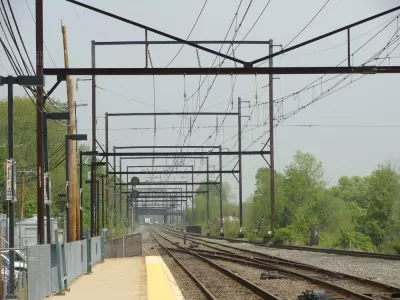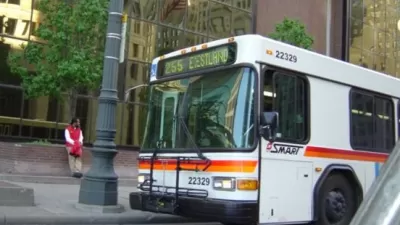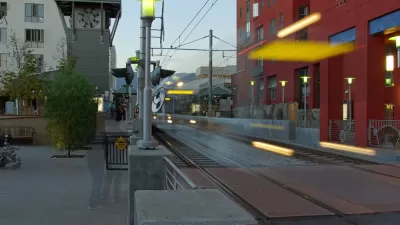With ridership revenue down, agencies seek to diversify their revenue stream by taking a more active role in developing agency-owned land.

With transit ridership down 79% in 2020 and a nationwide budget shortfall of close to $40 billion, writes Nate Berg for Fast Company, struggling public transit agencies are looking to revive their revenue through other means. Because many of them own land near their transit lines, some agencies are looking to the development of transit-agency-owned land as a potentially significant revenue source.
Until recently, most transit agencies used their land for surface parking, hoping ample parking near transit stations would draw more riders. But Jessie O'Malley Solis, transit-oriented development manager for the Santa Clara Valley Transportation Authority, says that in their area, it didn't work that way. "Just building seas of parking wasn’t going to generate ridership. You needed to generate connectivity along the system to make it valuable for riders." Now, as residents in Silicon Valley struggle to find housing in one of the country's least affordable markets, VTA is making plans to turn some of its land into "new transit-adjacent community hubs" and hopes its own development will have a ripple effect that encourages more private development near station areas. "O’Malley Solis says the development is always geared toward improving ridership and making more transit-oriented communities—whether it’s on land the agency owns or not."
While transit-oriented development isn't a silver bullet for increased ridership, "when done well, these projects can make an impact" on commuter mode share as well as increase the availability of affordable housing and the sustainability of transit agency budgets.
FULL STORY: Facing a $40 billion shortfall, U.S. transit agencies jump into real estate

Planetizen Federal Action Tracker
A weekly monitor of how Trump’s orders and actions are impacting planners and planning in America.

Congressman Proposes Bill to Rename DC Metro “Trump Train”
The Make Autorail Great Again Act would withhold federal funding to the system until the Washington Metropolitan Area Transit Authority (WMATA), rebrands as the Washington Metropolitan Authority for Greater Access (WMAGA).

The Simple Legislative Tool Transforming Vacant Downtowns
In California, Michigan and Georgia, an easy win is bringing dollars — and delight — back to city centers.

The States Losing Rural Delivery Rooms at an Alarming Pace
In some states, as few as 9% of rural hospitals still deliver babies. As a result, rising pre-term births, no adequate pre-term care and "harrowing" close calls are a growing reality.

The Small South Asian Republic Going all in on EVs
Thanks to one simple policy change less than five years ago, 65% of new cars in this Himalayan country are now electric.

DC Backpedals on Bike Lane Protection, Swaps Barriers for Paint
Citing aesthetic concerns, the city is removing the concrete barriers and flexposts that once separated Arizona Avenue cyclists from motor vehicles.
Urban Design for Planners 1: Software Tools
This six-course series explores essential urban design concepts using open source software and equips planners with the tools they need to participate fully in the urban design process.
Planning for Universal Design
Learn the tools for implementing Universal Design in planning regulations.
Smith Gee Studio
City of Charlotte
City of Camden Redevelopment Agency
City of Astoria
Transportation Research & Education Center (TREC) at Portland State University
US High Speed Rail Association
City of Camden Redevelopment Agency
Municipality of Princeton (NJ)





























